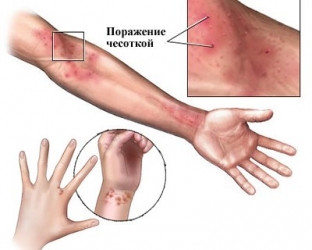Scabies is not always associated with an asocial lifestyle, and patients often do not realize the fact of contracting this infection, considering its symptoms to be manifestations of allergies. Sometimes extremely clean people become infected with scabies, while the symptoms become erased and resemble mild skin irritation as a result of stress. The doctor must remember that the patient could easily pick up the scabies mite at a party - from other people's things and even at home - through contact with an infected family member. Timely and accurate diagnosis of the disease will help prescribe adequate treatment.
Scabies is an ectoparasitic infection of the skin, and the role of the mite as the cause of this infection is often underestimated, although if the patient has pleomorphic pruritic papular rashes, the doctor should immediately consider the possibility of infection with the mite Sarcoptes scabiei.
The increase in tick infestations does not depend on the socio-economic situation (although the incidence is higher in underdeveloped countries), nor on the age or sex of patients. Often the cause of the spread of the disease in schools, hospitals, sanatoriums and rest homes, as well as in families, is the untimely recognition of the epidemic and, accordingly, inadequate treatment.
Scabies is easily transmitted by direct contact with the skin of an infected person or objects that the patient has come into contact with (chairs, curtains, towels, bedding, toys, household items).
Clinical characteristics and features of the course of scabies
The skin disease associated with scabies results from a type IV immunological reaction to the mite or its feces. Skin foci are different depending on the local and general immunological reaction.
The first complaint of a patient suffering from scabies is itching, especially at night. It is assumed that it is associated with increased activity of female ticks in warm and dark conditions and is an immune response to their waste products. Symptoms develop gradually, itching starts slowly, and patients usually cannot remember exactly when they had symptoms and rashes.
The most characteristic signs of scabies are burrows and vesicles, less common are papules, pustules, excoriations, nodes and blisters. The hands (interdigital spaces and palms), the lateral portions of the foot, the ankles and elbows, the mammary glands, the area around the navel, the genitals (especially the penis and scrotum), and the buttocks are affected. Accurate diagnosis requires identification of the mite or its eggs in the presence of scabies. The burrows can be expressed in the form of erythematous or edematous linear foci elevated above the surface, sometimes with vesicles on top.
Scabies can coexist as an additional infection with various skin diseases, especially sexually transmitted diseases, so it is important to diagnose it correctly.

Possible complications of scabies:
- urticarial reactions;
- persistent dermatitis;
- itching after treatment;
- nodular lesions;
- Psychological problems (parasitophobia).
General therapeutic recommendations for the treatment of scabies
There is a wide variety of scabicides, so the choice of treatment often depends on personal preference, drug availability, or the economic situation of the patient. In any case, it is necessary to confirm the diagnosis and determine the source of the infection in order to avoid re-infection.
Some questions need to be clarified to the patient before starting treatment. Because the use of scabicides can cause irritation, patients should be warned of the dangers of overtreatment and the doctor should only re-treat in cases of persistent and re-infection.
If a secondary infection is present, antibiotics are given. Sometimes itching persists for several weeks after the end of treatment, such patients are helped by antihistamines and emollients. Treatment should be carefully monitored, as most failures are due to inadequate use of the scabicide. The whole family and those who have been in contact with a person with scabies should be treated, even if they do not have signs of infection.
Further clinical studies are needed to evaluate the optimal treatment regimen for scabies and to rule out possible interactions of anti-scabies drugs with other drugs the patient is taking, including topical ones.






Add a comment